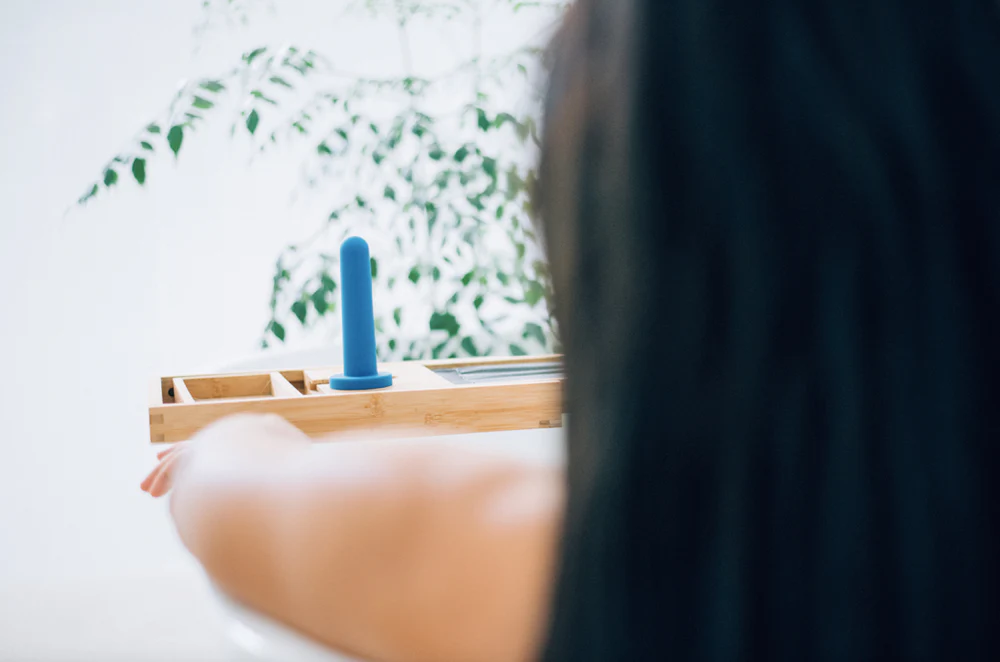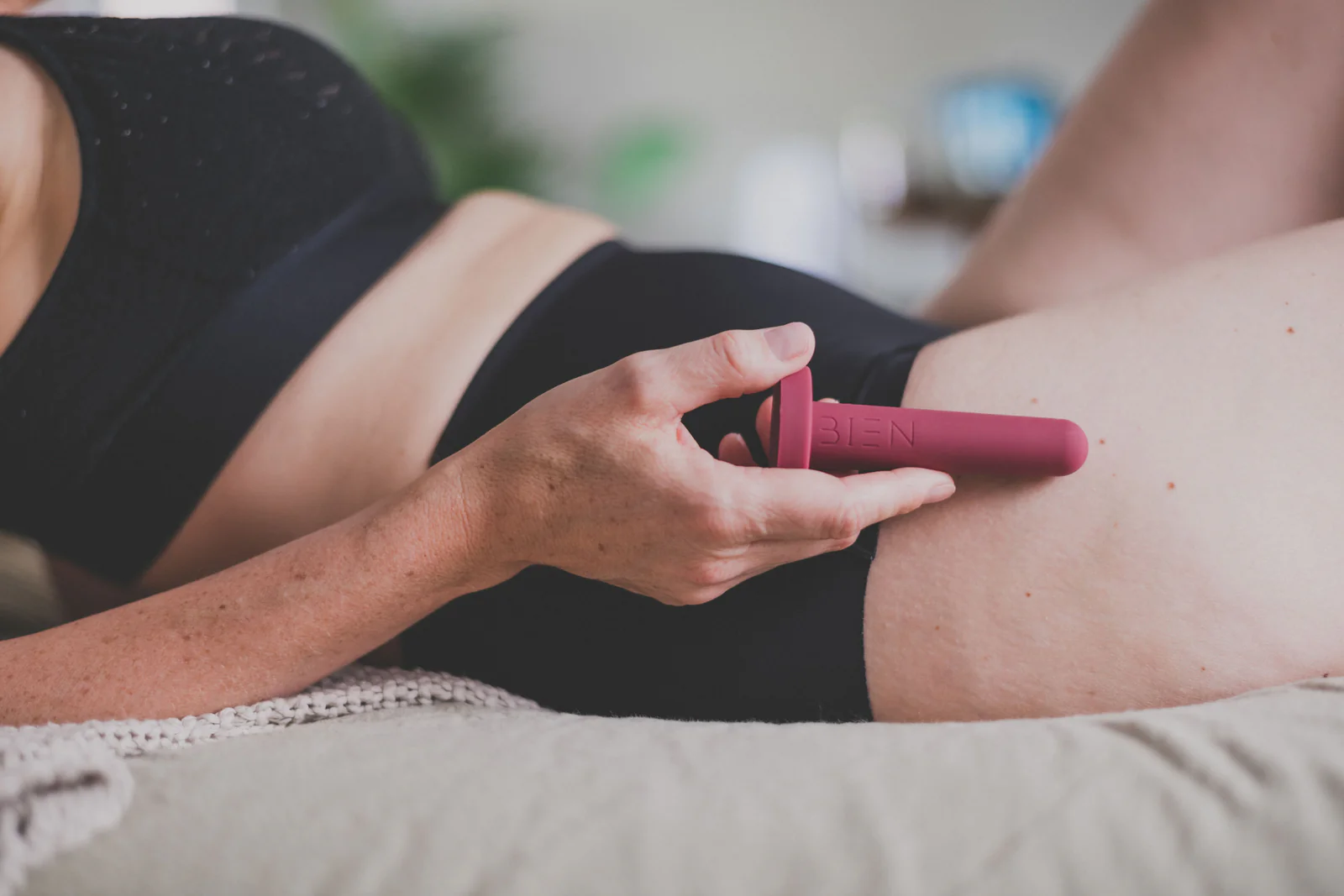Starting to use vaginal dilators can feel overwhelming, especially if you’re dealing with pain, anxiety, or uncertainty about your body. Whether you’re navigating recovery after surgery, managing a condition like vaginismus, or addressing vaginal tightness due to menopause or radiation therapy, dilator therapy can be an empowering and effective tool in your healing journey.
Recommended: Can Anxiety Alone Cause Vaginismus?
But like any treatment, success comes from starting in the right way—with proper guidance, patience, and realistic expectations.
In this guide, we’ll walk you through everything you need to know to begin using vaginal dilators safely and confidently, so you can take meaningful steps toward comfort, confidence, and sexual well-being.
Understanding Vaginal Dilators
Vaginal dilators are smooth, tube-shaped devices designed to gently stretch the vaginal tissues and pelvic floor muscles. They are used as a therapeutic tool to help individuals experiencing tightness, discomfort, or pain in the vaginal area. The goal is to gradually increase comfort with penetration—whether for medical exams, sexual activity, or general pelvic health.

People are often introduced to vaginal dilators for different reasons. Some use them to manage vaginismus, a condition where the vaginal muscles tighten involuntarily, making penetration painful or impossible. Others may begin using vaginal dilators after menopause, when hormonal changes can cause the vaginal walls to become thin, dry, or less elastic.
Recommended: Can You Have Vaginismus Without a History of Trauma?
They’re also frequently used during recovery from pelvic surgeries, radiation therapy, or gender-affirming procedures to maintain or restore vaginal depth and function. Additionally, those dealing with pelvic pain disorders like vulvodynia or recovering from childbirth-related trauma may benefit from gradual dilation therapy.
Though the reasons vary, the purpose is the same: to help individuals reconnect with their bodies in a safe, supportive way. When used consistently and with care, vaginal dilators can reduce pain, increase confidence, and improve quality of life.
Choosing the Right Dilator Set for You
Finding the right vaginal dilator set can make your therapy more comfortable and effective. Here are the main factors to consider, along with what each one means for your experience:
1. Size Range
Most sets come with multiple vaginal dilators of increasing size. Starting with the smallest size allows you to begin gently and progress gradually. Moving up too quickly can cause discomfort, so having a full set gives you more flexibility to go at your own pace.
Recommended: Is Burning During Penetration a Sign of Vaginismus?
2. Material
- Silicone, plastic, and glass are the most common materials.
- Silicone is soft, flexible, and body-safe—ideal for beginners or sensitive tissue.
- Plastic is firmer and can be easier to insert, though it may not feel as comfortable.
- Glass dilators are smooth and temperature-adaptable, but they’re firm and less forgiving.
Always look for non-porous, medical-grade materials to ensure hygiene and safety.
3. Shape and Flexibility
Some dilators are straight, while others are slightly curved to follow the vaginal canal’s natural shape. Flexible options may be easier to maneuver, especially if you have a tilted uterus or are dealing with muscle tension.
4. Ease of Cleaning
Choose vaginal dilators that are easy to sterilize—ideally dishwasher-safe or able to be cleaned with warm water and gentle soap. Avoid porous materials that can trap bacteria or irritants.
5. Extra Features
Some dilators come with added features like vibration. These can help relax pelvic floor muscles further and reduce pain, though they’re not necessary for everyone. Only choose vibrational options if they feel right for your comfort and therapy goals.
6. Storage and Discretion
Some sets come with discreet carrying cases or pouches. If privacy or portability is important to you, this could be a helpful bonus.
Recommended: Can Vaginismus Develop Suddenly?
7. Medical Guidance
If you’re unsure what to choose, it’s worth speaking with a pelvic health professional. They can recommend specific types or brands based on your anatomy, condition, and comfort level.
Step-by-Step Guide to Your First Dilator Session
Starting your first vaginal dilator session can feel intimidating, but taking it slow and approaching it with patience can make the process more comfortable and empowering. Here’s a step-by-step guide to help you get started safely and confidently:
1. Set the Scene
Find a quiet, private space where you feel safe and relaxed. Choose a time when you won’t be rushed or interrupted. You might want to play calming music, dim the lights, or have a warm blanket nearby—anything that helps you feel at ease.
2. Wash Your Hands and Dilator

Before you begin, wash your hands thoroughly with soap and water. Clean the dilator with warm water and a gentle, unscented soap (or follow the manufacturer’s instructions). This helps prevent irritation or infection.
Recommended: Effective Mindfulness Practices for Reducing Female Stress and Low Libido
3. Use a Water-Based Lubricant
Apply a generous amount of water-based lubricant to the tip and shaft of the dilator, and a little around the vaginal opening. This reduces friction and makes insertion more comfortable. Avoid silicone-based lubes if you’re using silicone dilators, as they can damage the material.
4. Get Into a Comfortable Position
Lie down on your back with your knees bent and legs apart, or try a side-lying position with a pillow between your knees. You can also experiment with sitting or propping yourself up until you find what feels most natural and relaxed.
5. Take a Few Deep Breaths
Before inserting the dilator, take slow, deep breaths to help your body relax. Focus on releasing tension in your pelvic area with each exhale. Try not to rush—your comfort is the priority.
6. Gently Insert the Dilator
With one hand, gently spread the labia and, with the other, slowly insert the dilator into the vaginal opening. Aim slightly downward, toward your lower back, rather than straight up. Only insert it as far as feels comfortable—don’t force it.
7. Hold and Breathe
Once inserted, hold the dilator in place for 5 to 10 minutes, or as long as recommended by your provider. Continue breathing deeply and try to relax the pelvic floor. If you feel cramping or resistance, pause and try to release the tension.
8. Gently Remove and Clean
When you’re ready, slowly and gently remove the dilator. Wash it with mild soap and warm water, dry it thoroughly, and store it in a clean container or case.
Recommended: Holistic Tips for Boosting Female Libido Without Medication
9. Reflect and Rest
Take a moment afterward to notice how your body feels—physically and emotionally. You might want to write down your experience in a journal to track your progress over time. If you feel sore, a warm bath or gentle stretching may help.
Common Challenges and How to Overcome Them
While vaginal dilator therapy can be incredibly helpful, it’s common to encounter some challenges along the way. It’s important to remember that these challenges are normal and part of the process. Here are some of the most common obstacles people face and ways to overcome them:
1. Discomfort or Pain During Insertion
Many people experience discomfort or even pain when they first start using vaginal dilators, especially if the pelvic muscles are tense or the vaginal tissues are dry.
How to Overcome It:
- Use a generous amount of water-based lubricant to reduce friction.
- Start with the smallest dilator and gradually work your way up in size. Going too big too soon can cause unnecessary discomfort.
- Try using a heating pad or taking a warm bath before your session to help relax the pelvic muscles.
- Consider consulting a pelvic floor therapist for personalized guidance on techniques for relaxation and comfort.
2. Anxiety or Emotional Resistance
For many, the emotional aspect of using vaginal dilators can be just as challenging as the physical one. Fear, anxiety, or frustration can arise, especially if past experiences with pain or trauma are involved.
Recommended: Can Anxiety Alone Cause Vaginismus?
How to Overcome It:
- Take it slow and give yourself permission to go at your own pace. There’s no rush—listen to your body.
- Practice deep breathing and mindfulness techniques before and during your sessions to help manage anxiety.
- If emotional resistance persists, it may be helpful to talk to a therapist, especially one who specializes in pelvic health or sexual health.
- Celebrate small victories, whether it’s completing a session or feeling less tense.
3. Difficulty in Inserting the Dilator

Sometimes, the dilator may feel difficult to insert, especially if there’s resistance or tightness in the pelvic area. This can be discouraging, but it’s important to stay patient.
How to Overcome It:
- Make sure you are fully relaxed—tension in the pelvic muscles can make insertion more difficult. Take deep breaths to help release any tightness.
- Ensure that you’re using enough lubricant and that you’re inserting the dilator slowly and gently.
- Change your position to find what feels most comfortable. Some people find it easier to insert the dilator while lying down, while others prefer sitting or standing.
- If you continue to face difficulty, a pelvic floor therapist can offer advice and may suggest specific techniques to help with muscle relaxation.
4. Frustration with Slow Progress
It’s natural to feel frustrated if you’re not seeing progress as quickly as you’d like. Remember that healing and comfort take time, and everyone’s journey is different.
How to Overcome It:
- Set realistic goals for yourself. Don’t expect immediate results—small steps and gradual improvement are signs of success.
- Track your progress in a journal or app to keep track of your sessions and how your body feels. This can help you see progress, even if it feels slow.
- Celebrate each session, even if it’s just a small one. Every time you use the dilator, you are working toward healing.
5. Vaginal Dryness or Irritation
Vaginal dryness can sometimes make dilator use uncomfortable, especially during menopause or as a result of certain medications or conditions.
How to Overcome It:
- Always use a water-based lubricant before insertion, as this will reduce friction and increase comfort.
- Consider using a vaginal moisturizer in addition to lubricant to keep the vaginal tissues hydrated between sessions.
- If dryness or irritation persists, speak to your doctor or healthcare provider to explore additional treatment options or adjustments to your routine.
6. Physical Fatigue or Discomfort After Sessions
It’s not uncommon to feel sore or fatigued after using a dilator, especially in the beginning.
How to Overcome It:
- Start with shorter sessions (5-10 minutes) and gradually increase the duration as your body becomes more accustomed to the dilator.
- Take a warm bath, apply a heating pad, or practice gentle pelvic floor stretches to relax the muscles after a session.
- If you’re experiencing ongoing discomfort or fatigue, it’s a good idea to consult your healthcare provider for further advice.
Conclusion
Starting vaginal dilator therapy is a deeply personal journey that takes time, patience, and self-compassion. Whether you’re using dilators to manage pain, recover from a medical procedure, or reconnect with your body, the key is to go at your own pace and honor what feels right for you. With the right tools, a comfortable environment, and guidance from a healthcare provider, dilator therapy can become a powerful part of your healing process.
Remember, progress isn’t always linear—some days may be harder than others, and that’s okay. Every small step is a victory, and with consistency and care, you can build both physical comfort and emotional confidence. Don’t hesitate to seek support when needed, and most importantly, be kind to yourself throughout the journey.
